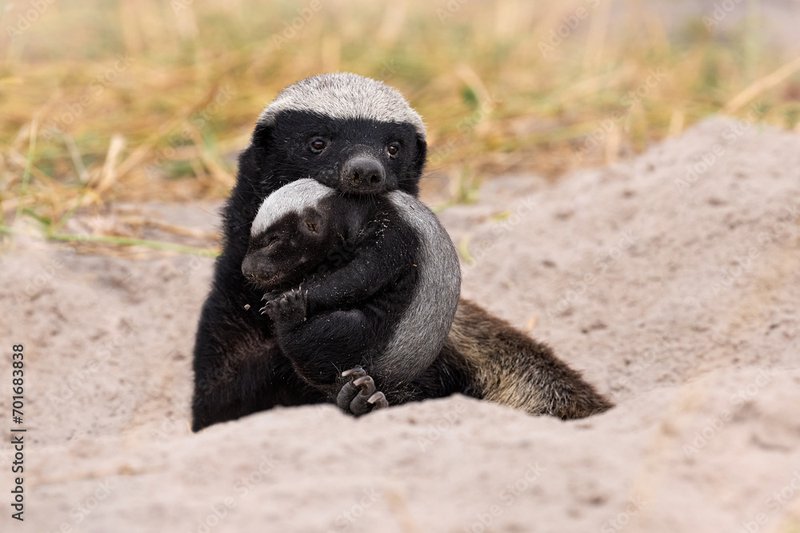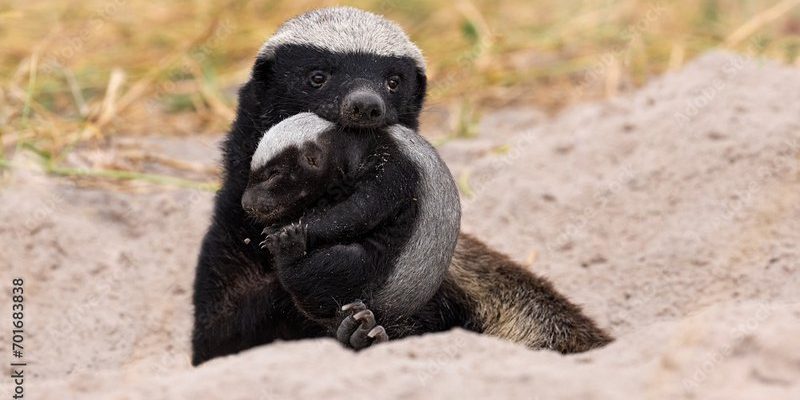
Imagine a tiny, determined creature navigating the wilds of Africa. Honey badgers are not just brave; they’re smart, and when it comes to raising their young, they apply a mix of instinct and learned behavior. By understanding how these animals nurture and protect their cubs, we can better appreciate the complexities of life in the wild. So grab your coffee, and let’s explore how honey badgers go about raising their young!
Honey Badger Reproduction and Family Life
Honey badgers are part of the weasel family, and they have a pretty interesting family life. Breeding typically happens once a year, with females producing a litter of usually one to three cubs. After a gestation period of about seven weeks, the female gives birth in a burrow or a secluded spot, which offers safety from predators.
Here’s the thing: right from birth, honey badger cubs are pretty much helpless. They’re born blind and completely dependent on their mother. The first few weeks are crucial because the mother needs to provide everything, from warmth to food. This means she’ll spend a lot of time in the den, nursing her young and keeping them safe.
Once the cubs are a few weeks old, they start to grow rapidly. They begin to crawl and eventually explore their surroundings. The mother encourages this exploration, as it’s essential for the cubs to learn how to navigate their environment. This stage of development is critical, as it sets the foundation for their future independence.
Mother Honey Badger’s Role
The mother honey badger plays a vital role in raising her cubs. She is fiercely protective, and her dedication to her young is apparent. While she hunts for food, she is always on alert for any threats. Honey badgers are known for their bravery, and mothers are no different—when it comes to protecting their cubs, they’ll face off against much larger predators.
Interestingly, the mother provides not just food but also education. She teaches her cubs important survival skills, like how to dig for insects or how to scavenge effectively. Watching her hunt and forage helps the cubs learn what to eat and what to avoid. It’s like a crash course in survival, right in the heart of the wild!
As the cubs grow, they begin to accompany their mother on hunts. This teamwork helps them practice their skills while still benefiting from the safety of their mother’s protection. It’s a beautiful, if sometimes chaotic, learning process that blends play with the serious business of survival.
Social Structure and Independence
Honey badgers don’t form large family groups like elephants or wolves. Instead, they tend to be solitary animals, with mothers raising their cubs alone. This independence means the cubs need to learn quickly how to fend for themselves.
Around six months of age, the cubs are ready to start transitioning away from their mother. However, they often remain with her for a while longer, sometimes for up to a year, until they are fully capable of surviving on their own. This extended family time is essential; it allows them to solidify their skills and prepare for the challenges they’ll face outside the safety of the den.
During this time, you might notice the mother and cubs engage in playful behavior. This is not just for fun; it’s vital for developing the physical and social skills they’ll need. Think of it as their version of a training camp, where every tumble and tussle is a step toward becoming a competent and fearless adult honey badger.
Protecting the Young
Protection is a top priority for honey badger mothers. They have to be vigilant and prepared for any potential threats, whether it’s a larger predator or human interference. The harsh reality is that life in the wild can be dangerous, and mothers must be ever-watchful.
One of the most remarkable traits of honey badgers is their ability to defend themselves. They’re known for their aggressive behavior and their willingness to fight, even against animals much larger than themselves. This tenacity extends to their cubs, as mothers will fiercely protect their young from any danger.
When a threat is detected, the mother doesn’t hesitate to act. She might move her cubs to a different den or confront the predator directly. In this way, she not only protects them but also teaches them about danger and how to respond. It’s a tough love approach, but it’s one that ensures her cubs are prepared for the world outside the den.
Cubs’ Learning Experience
As the cubs grow, their learning experience becomes richer and more complex. They don’t just learn from their mother; they also observe the world around them. This observational learning is crucial for honey badgers. They often watch other animals to learn about food sources or potential threats, absorbing vital information they’ll use later.
You might be wondering how a mother balances teaching with keeping the cubs safe. Well, she uses a strategy of gradual exposure. Initially, she keeps her cubs close to home, but as they become more confident, she introduces them to different environments. This hands-on experience is critical, as it helps the cubs develop the necessary skills for hunting and foraging.
In fact, these early experiences shape how effective they’ll be once they’re on their own. By the time they reach independence, they’ve amassed a wealth of knowledge and skills, all thanks to their mother’s guidance and their own curiosity.
Life After Independence
When honey badger cubs finally become independent, they’re ready to face the wild on their own. This transition, however, can be a bitter-sweet moment. The mother will have spent much time teaching and protecting them, but once they’re ready, it’s time to let go.
Newly independent honey badgers will typically wander off to establish their territories. They use the skills learned from their mother to navigate their new lives, from digging for food to avoiding danger. It’s a hard world out there, but their upbringing prepares them well.
Interestingly, some young honey badgers may stay in the vicinity of their mother for a little while, depending on available resources. This might allow them to learn even more about survival strategies before fully venturing out.
Ultimately, honey badgers thrive in their wild environments due to their fierce independence and the strong foundation laid by their mothers. This life cycle highlights both the beauty and the challenges of raising young in the wild.
Raising young in the wild is a tough job, and honey badgers do it with a blend of love, protection, and teaching. From the moment they’re born, cubs rely on their mothers to learn everything they need for survival. Honey badger mothers showcase the balance of nurturing and tough love, ensuring their young are well-prepared for the challenges ahead.
By understanding how honey badgers raise their young, we gain insight into the complexities of wildlife parenting. It’s a world full of risks, but also of incredible resilience and strategy. Next time you think of honey badgers, remember that beneath those tough exteriors lies a nurturing spirit, ready to teach the next generation how to thrive.

